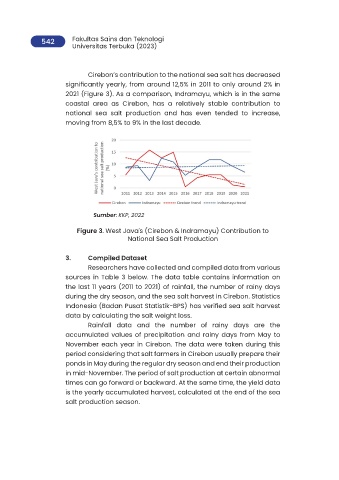Page 581 - Trends in Science and Technology fo Sustainable Living
P. 581
542 Fakultas Sains dan Teknologi
Universitas Terbuka (2023)
Cirebon’s contribution to the national sea salt has decreased
significantly yearly, from around 12,5% in 2011 to only around 2% in
2021 (Figure 3). As a comparison, Indramayu, which is in the same
coastal area as Cirebon, has a relatively stable contribution to
national sea salt production and has even tended to increase,
moving from 8,5% to 9% in the last decade.
Sumber: KKP, 2022
Figure 3. West Java's (Cirebon & Indramayu) Contribution to
National Sea Salt Production
3. Compiled Dataset
Researchers have collected and compiled data from various
sources in Table 3 below. The data table contains information on
the last 11 years (2011 to 2021) of rainfall, the number of rainy days
during the dry season, and the sea salt harvest in Cirebon. Statistics
Indonesia (Badan Pusat Statistik-BPS) has verified sea salt harvest
data by calculating the salt weight loss.
Rainfall data and the number of rainy days are the
accumulated values of precipitation and rainy days from May to
November each year in Cirebon. The data were taken during this
period considering that salt farmers in Cirebon usually prepare their
ponds in May during the regular dry season and end their production
in mid-November. The period of salt production at certain abnormal
times can go forward or backward. At the same time, the yield data
is the yearly accumulated harvest, calculated at the end of the sea
salt production season.

